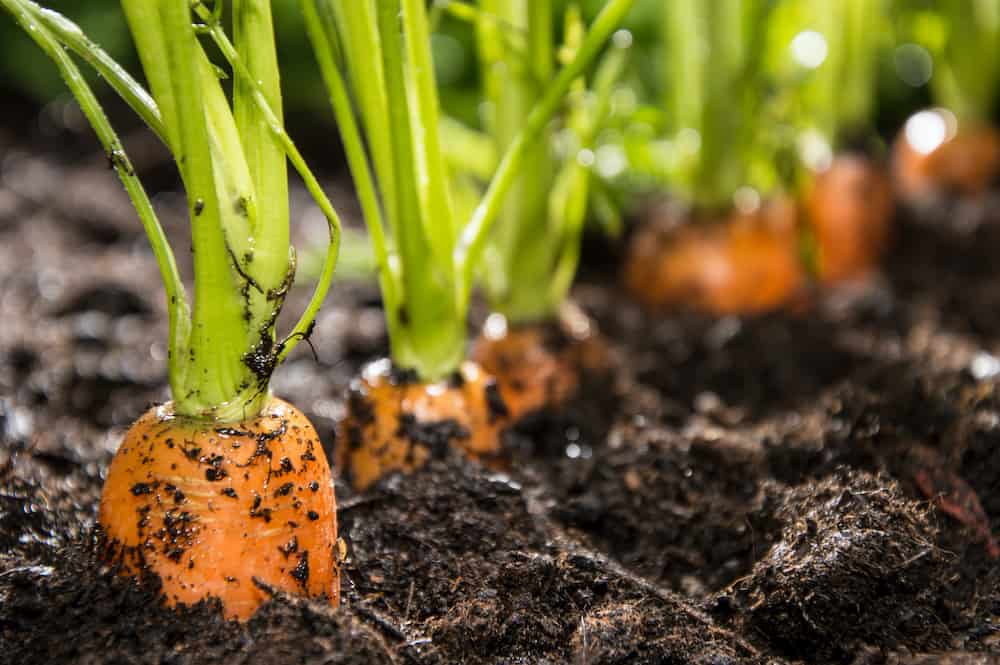Carrots are easy to grow making them a good choice for beginning gardeners. Learn how to grow carrots with these tips. They are cool season crops and grow well in climate hardiness zones 3 – 10. Carrot plants can be annuals or biennials. They are root vegetables and grow underground.
I’ve had success growing carrots in raised garden beds and in tall containers. When I’ve tried growing them directly in the ground (in enriched soil), critters got to them before I did. I didn’t have this problem when I grew them in garden beds and planters.
Be sure to get the dirt off the carrots outside. After brushing off what I can by hand, I also hose the off. You can also bring a pitcher of water from inside to rinse them off. This will help keep soil out of your kitchen drain.
For beginning or experienced gardeners, carrots are a good choice. Learn the right soil conditions and when to sow carrot seeds. With many carrot varieties to choose from, you can add unique flavors to your dishes. They are fun to grow and a great way to get kids interested in the concept of farm to table.
How to Grow Carrots
Carrots are highly resistant to disease and usually resistant to cracks.
Where to plant carrots
There are two things to consider when choosing where to plant carrots:
- Sunlight
- Soil quality
You’ll want to choose a location with access to full sunlight, at least 6 hours each day. While carrots grow best with access to light, they are relatively tolerant of shade as well. Choose an area in the garden that has loose soil without rocks.
Plant carrots in:
- In the ground
- Raised garden bed
- Tall pots and containers
- Large fabric grow bags
It can be tempting to try to transplant your carrots, but it’s best to plant them directly into your garden or the containers where they will grow for their entire lifespan. Planting carrots from seed is easy, even for beginners. They are among the easiest vegetables to grow.
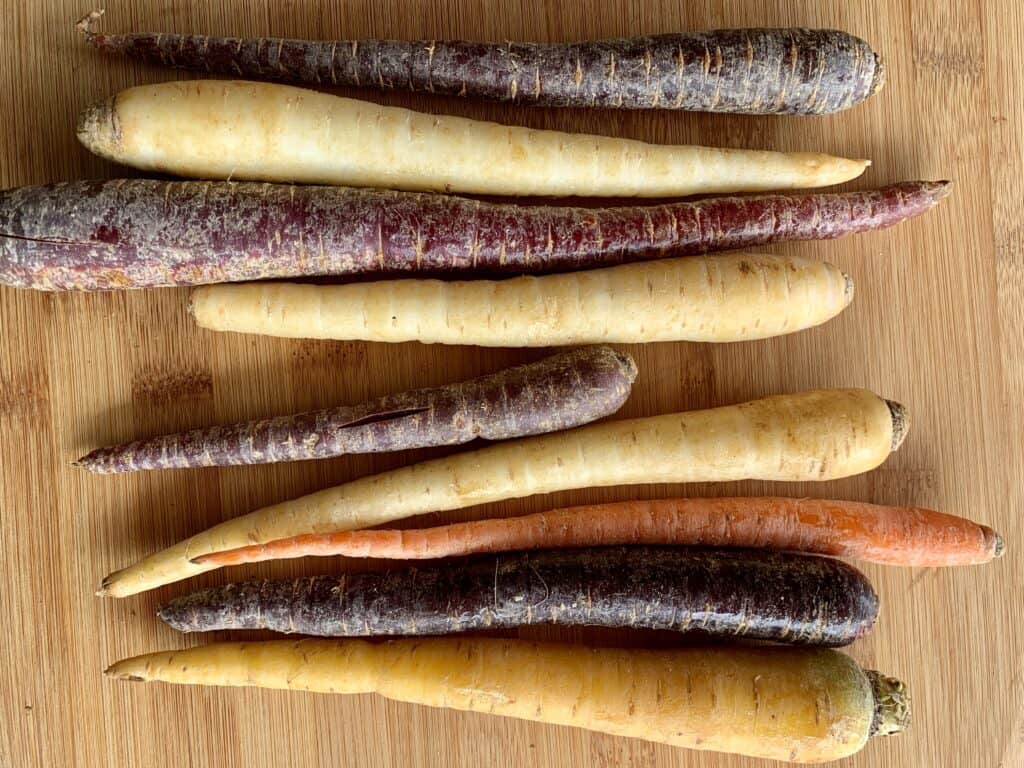
Soil to grow carrots
Growing carrots requires loose soil that is well-draining. They must be able to grow without being obstructed. Carrot roots must have access to nutrient-rich soil. You can buy organic potting soil from garden centers and hardware stores.
Work the soil to one foot deep to be sure nothing will hinder growth. Then amend with compost as well as sand or vermiculite.
When planting carrot seeds, you can add coffee grounds to the soil which will help boost development. Do not add fertilizer until they are established.
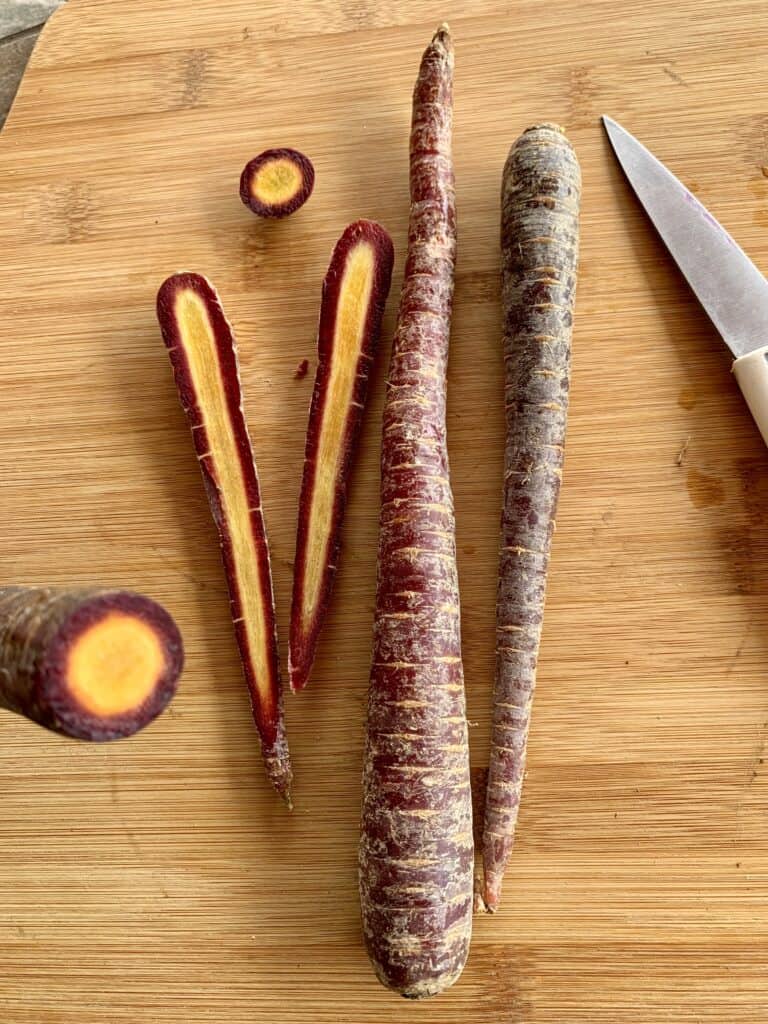
When to plant carrots
Gardeners should start to sow carrot seeds approximately 3 – 5 weeks before the last frost date of the spring, which you can easily find with a quick online search of your area. You can also choose carrot varieties to grow in the fall and winter. Plant these carrot seed varieties 2 – 3 months before the average first frost. Depending on where you live, that will be in fall or winter.
Depending on the number of harvests you want to have throughout the year, you might have to sow seeds every three weeks to encourage the growth of a higher number of carrots.
How far to space carrots
You will also want to take care not to plant the seeds too close together, which is where a seed sower might come into great use. Carrot seeds are tiny. Be sure each carrot will have enough space. Ideally, carrots should be planted 3 – 4 inches apart. If you are gardening in a square foot, you can plant 16 seeds.
How deep to plant carrot seeds
Make sure that you sow the seeds at least ¼-inch deep into the soil. Cover the seeds with a layer of fine compost or vermiculite when finished.
Germination
Carrot seeds germinate slowly. They take between 14 – 21 days to sprout. To speed up germination, you can soak them in water overnight, and leave them to dry on a paper towel for three days before planting.
Companion plants
You can grow carrots with other carrots or with other cool season crops such as garlic, onions, radishes, leeks, lettuce, and beans.
Watering
As with any of the other fruits and vegetables in your garden, you should have a watering schedule established to provide your plants with the essentials they need to grow quickly and healthily. With carrots, you will need to water them frequently to keep the soil moist. They require one inch of water per week.
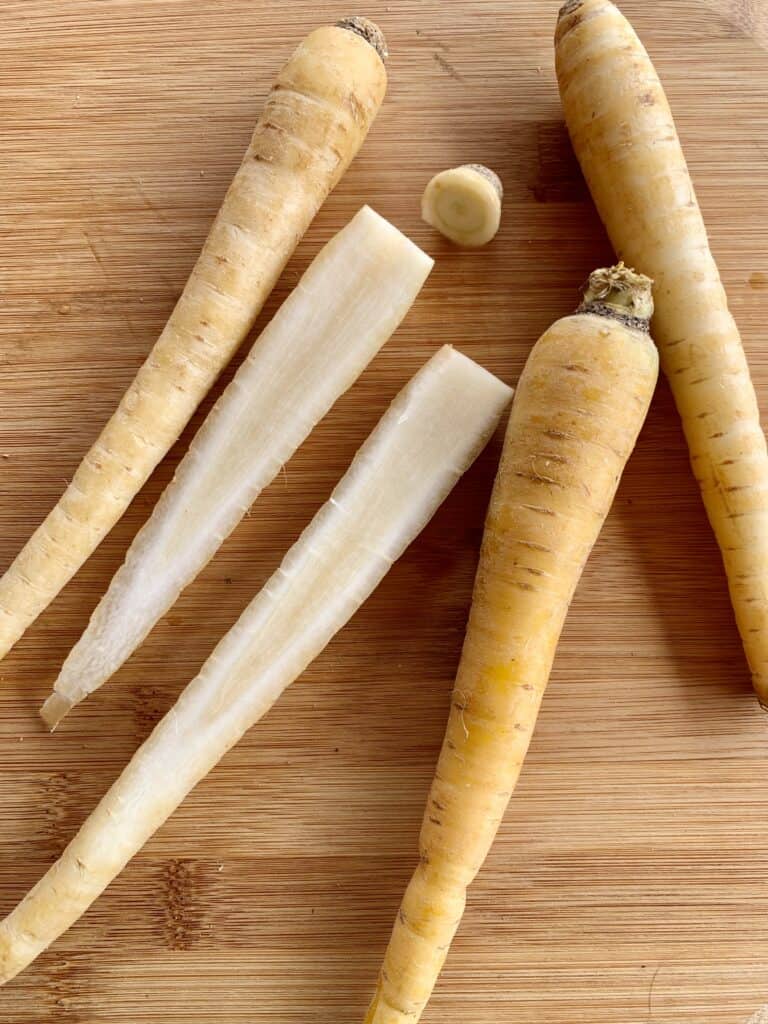
It is also essential that you prevent a crust from forming on top of the seeds while they are germinating, which is where the vermiculite or fine compost can be quite handy.
Typically, if you were to insert your finger to your middle knuckle into the garden, you should feel a dampness in the soil. However, it shouldn’t be wet.
Fertilizer
Fertilize carrots when the tops are over three inches. Carrots will thrive with fertilizer that contains potassium. They do not grow well with extra nitrogen. High nitrogen content may cause the carrots to sprout side roots and obstruct the other root systems.
Carrot Pests and Diseases
When watering carrot plants, check for insects and for damage. Some to watch out for include:
- Carrot weevils: Similar to a beetle
- Carrot rust
- Nematodes
- Parsley worms
- Bacterial diseases: vegetable soft rot, leaf blight, carrot black rot, bacterial soft rot
- Fungal disease
Patience
Even though we all would love for our plants to start growing immediately after sowing, that certainly isn’t the case, especially with carrots. On average, your new crop can take up to three weeks to even sprout leaves, so if you haven’t seen any signs of growth right away, it’s important to be patient.
Take the time to weed the area without disturbing the roots of your young carrots. Inspect for insects. In addition, ensure the soil retains its moisture.

Harvesting Carrots
Now that you have an idea of how you can plant carrots in your garden, it’s essential to be prepared for when it comes time to harvest them and store them for later use. Generally, the smaller the carrot, the bigger and bolder its taste will be, so you will want to consider how large they are before you harvest them.
How do you know when a carrot is ready? Environmental conditions as well as the variety of carrot will vary. Most carrots will be ready to harvest in 70 – 80 days. If you bought carrot seeds, save the package to learn how long they will take to mature. Each variety is different. This will be listed as DTM (days to maturity).
You can usually harvest them after about 60 days, however, it’s best to let them fully mature.
Because carrots grow underground, it is difficult to determine their size. You can tell when carrots are ready to pick by measuring how wide the shoulder is. This is the part of the carrot that you see coming out of ground.
How to harvest carrots
When harvesting carrots, you will want to pull them out of the ground, rather than use spading forks as they can bruise the roots. Ensure that you loosen the soil gently before pulling. You might find that watering the carrots before removing them can help to make the process even simpler.
If you haven’t removed your carrots during your annual harvest, they will produce seeds next year, as they are biennial (have a two-year life cycle). In their first year, they grow leaves and a long taproot (the “carrot”). If they develop and are left in the ground, in their second year, they will use their nutrients from the root to grow flowers and seeds.
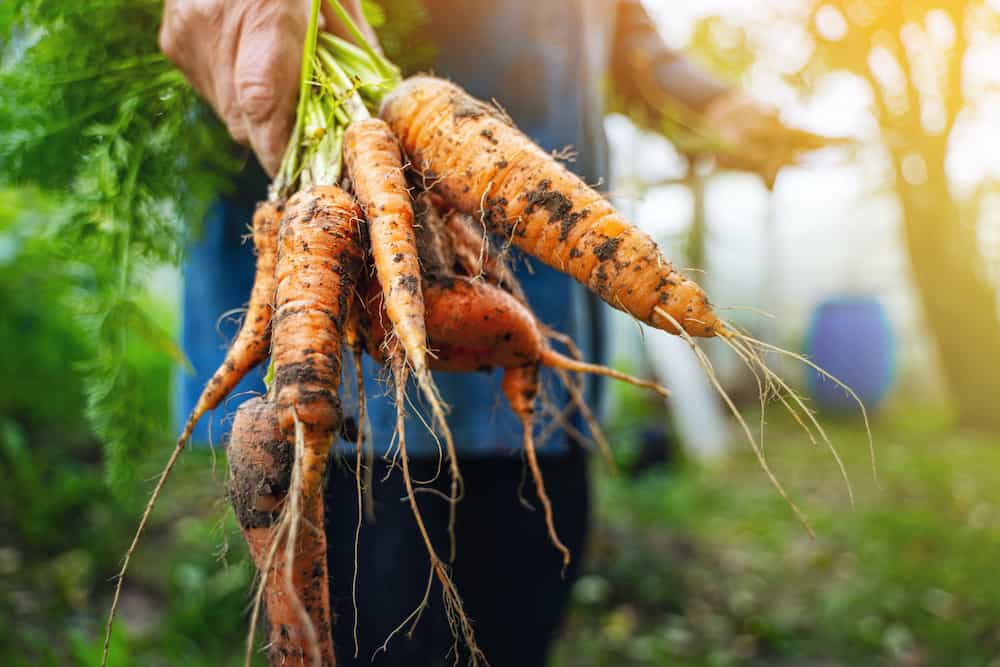
Tips for Storing Carrots
Fresh carrots behave quite differently than store-bought carrots, which means they will require a couple of extra steps for storage to prevent them from wilting and going soft within a couple of hours of being harvested.
Once you’ve pulled carrots from the ground, you will want to scrub away dirt using cold water. Next, cut most of the top off, leaving approximately half an inch behind.
It’s also a good idea to let them air dry, rather than to pat them down with a towel. As soon as the carrots are dry, seal them in an air-tight container or plastic bag before refrigerating. Otherwise, they are going to go limp inside of the fridge if they aren’t protected.
Many gardeners also find that you can store carrots in dry sawdust in a cool and dry area instead of the fridge, depending on how many you need to use at a single time.
Growing Carrots FAQs
Growing carrots is pretty straightforward, but there are a few essential questions to note before you get started. Here are FAQs about growing carrots for beginners.
How long does it take to grow carrots?
You can quickly grow a healthy crop of carrots within 70 to 80 days, depending on the variety of carrots, environmental conditions, and soil quality. Carrots take up to 21 days to germinate.
Making sure that you sow multiple rows can give you plenty of different carrots to enjoy throughout the year. Novice gardeners will also want to ask, how long does it take to grow carrots? Some varieties grow faster than others.
Can you grow a carrot from a carrot?
If you’re wondering, can you grow a carrot from a carrot, the answer is yes. As long as you still have carrot top and not the root vegetable, you are able to grow a carrot from a carrot.
Cut the top of the carrot off so that you have one inch of the root. Put in a glass with water. Ensure the bottom part of the carrot is in the water. Placing the glass near available sunlight will encourage more roots to grow within the glass, which you can transplant.
What types of carrots are there?
The scientific name is Daucus carota subsp. sativus. There are many carrots varieties. Carrots are available in different colors, shapes and sizes.
Not only do you have the opportunity to plant the traditional orange carrots, but you can also choose from an assortment of other colors, such as white, yellow, purple, or crimson.
The most popular carrot varieties include:
- Bolero: These carrots are up to eight inches long and are ideal for resisting blights and leaf pests.
- Danvers: Also known as Classic Heirloom carrots, they can be up to eight inches long as well with a tapered end and a richness that is ideal for heavy soil.
- Little Finger: Much like their name suggests, Little Finger carrots are only four inches, but they can grow up to one-inch thick.
- Nantes: Known for their incredible crunchy and sweet texture and flavor, Nantes can grow up to seven inches and have a more cylindrical body.
- Thumberline: If you’re growing in containers or only have clay soil, Thumberlines are a phenomenal option as they produce round carrots that are best for clumpy conditions.
How do you grow tastier carrots?
If you’ve planted carrots in the fall, it could be beneficial to wait for a couple of frosts to go by before harvesting. This can help to make the carrots even more flavorful.
When soil frosts, it encourages the plants to reserve their energy. This boosts the production of sugar within the vegetable and enhances its taste. Carrots who have gone through one to two touches of frost are bound to be far tastier than those that haven’t.
What if I don’t pick all my carrots?
Carrots have a two year life cycle. They are biennials. If you don’t pick all of your carrots, they will flower in their second season of growth. They will self-sow if they survive the winter.
Versatile Root Crops
There are plenty of reasons why carrots are such a popular vegetable choice for beginner and experienced gardeners. They are a cool season crop which makes it practical to grow in the fall, winter, spring in many areas. Knowing how to grow carrots can give you a healthy root vegetable that can be perfectly paired with several dishes, from roasts and salads to a casual snack during the day.
With the proper planting technique, you won’t have to worry about throwing away ones that have rotted or failed to sprout.
When planting carrots, be sure to spend enough time planning for the crop to fully mature with little issues. Use these best tips for growing carrot plants. Beginners can learn how to grow carrots and be successful with a bountiful crop.

